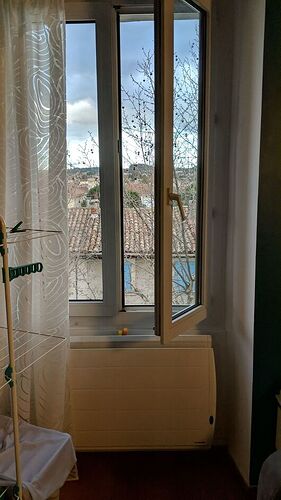Ok, before I had a baby I kept up on the forums, and I’ve done a quick search to see if anything else has been posted in the last seven months, but haven’t found anything that matches my case. I need some help/inspiration/tips for a venting setup on my window…that has a single pane of two layers (can’t put a hole into it), is a meter and a half tall, and opens inward.
We tried the whole velcro-cloth contraption last summer with a portable a/c unit, and it was an utter fail. And because the window I want to use is in the ‘guest room area’ (I have one giant room downstairs, where the living area and kitchen and entryway hall are attached) I need to be able to remove it when we use the pull out bed, so taping something directly won’t work. I can’t drill holes in the walls either, because my apartment is in a 400 year old building and the stone walls are quite literally over half a meter thick (yay south of France!). The wall behind the radiator is a bit thinner, but there isn’t enough room to go under. Notice too that I have only one handle to open the window, which means I can’t brace it shut that way. (also scary given that I have a baby who looks like he might start climbing early…and we’re on the 4th floor!)
Please help, all you crazy inventive DIY-ers out there!
Pic of my window: (please excuse the drying rack)
1 Like
I’d suggest looking to get a mag-vent and have lexan cut to match the glass in the window, but with a hole for the mag vent and the matching 8 screw holes. Replace the glass in the window sash with the Lexan, and use the mag vent to attach the venting hose to the mag vent receiving part when running the forge. Create a metal cap to cover the magvent (its magnetic) when not using the forge.
If you look in my thread, similar topic, you can see what I did, but since it’s a basement window, I just used plywood since I wasn’t going to have the Window visible from the outside. I’ve copied one pic here.
Here is a pic with the hose detached.
https://community.glowforge.com/uploads/short-url/pEAB99Jy7CibEQ0VbNncChPf2oC.JPG
1 Like
I did see that, but what would that do in terms of noise reduction? We live in a busy street that can be very noisy, and if I’m not running the laser it would be nice to still have that. There are two layers of glass there, not just one.
Then I would speak to a window repair shop to see if they could cut out a round hole or replace the glass with a smaller double pane glass and put an equivalently thick piece of wood in the bottom portion so you could attach the magvent in that.
Would you be allowed to add an external pane of lexan that meets @todd.hassell’s description over the outside of the window opening?
Then you could open your existing window to magnet-attach venting to the outer pane.
You might even put it on a hinge opening out so you could get air into the home when you want the window open.
2 Likes
I wouldn’t be all too worried about the noise from outside when running the GF, it’s a bit of a rock concert by itself 
That being said, I haven’t been to your house and don’t know if car/people noise bothers yoy more than fan noise, so take anything I say with a grain of salt.
I’ve run Epilog and FSL lasers before, so I know about how loud they are…I’m thinking more when I’m not running the laser. We have a lot of motorcycles go by at 2 in the morning, and often the bar downstairs plays really loud music almost that late during the summers. 
Does the window open further?
From what I can see the window closes on a lip on the outside edge. You could cut a piece of plywood the same size as the window so that it seals against that existing weather stripping.
Then you can add some 1 x 1 (whatever size fits) around edge to frame it and help it snug into the gap. That should be secure and still be removable.
For noise and temperature you can use some rigid insulation the same thickness as the framing around the edge. For looks you could add another layer of ply on the inside face and finish it to match the room.
Depending on the materials used it can be fairly light and removable while remaining secure and insulating.
1 Like
Oooh…at first I didn’t quite understand what you meant, and further inspection of my window looks like i could maybe hinge it to the outside frame, but I’m not sure how I could latch it shut because there isn’t a center bar. BUT…I could maybe get a lexan pane to slide in and brace against the existing frame (since the window opens inward)…that would be non destructive and I could probably wedge foam to seal the edges…
I did something similar to @todd.hassell. I cut a few pieces with my GF and glued them together. Added some weather stripping to the top, bottom and sides. Could you get a screen that is 6 inches or so shorter than the one you have now and place a 6 inch piece of plywood at the bottom of it. I added leather handles to mine so it’s easy to put in and take out. I’m guessing your local hardware store would have a cap you could put in the hole. Example. You would probably need to add some way of securing it in place though.
I’m in the south of France…I think I can count on one hand the number of times I’ve seen a window with a screen in it! We’ve never really had a problem with bugs (other than a few flies) either. But yeah, something I can wedge in the window space while the window is open is probably what I will do. I have an idea for something similar to the weather stripping. Handles are a good idea, also some kind of safety connector to something inside…wouldn’t want to actually lose hold of it and have it land on someone’s head four stories below 
I have a similar and (i hope!) temporary issue but I have a lot of Velcro and some heavy canvas like Nylon fabric. The fabric even was able to fit under the lid of the Glowforge so I was able to cut exactly the size round hole I needed and it sealed the threads nicely. then with spray adhesive on the backs of the fuzzy side of the velcro (or you can buy the already sticky) and put that on the part of the frame you can reach and sew or stick the other hook half to the canvas with the hole (you could even add insulation) and you have an easily replaceable easy to take down exhaust that guests might not even notice when it is not hooked up.




